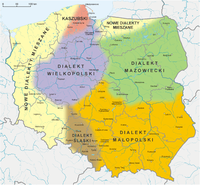
Pomerania
Pomerania (Polish: ⓘ ; German: ⓘ ; Kashubian: Pòmòrskô; Swedish: Pommern) is a historical region on the southern shore of the Baltic Sea in Central Europe, split between Poland and Germany. The central and eastern part belongs to the West Pomeranian, Pomeranian and Kuyavian-Pomeranian voivodeships of Poland, while the western part belongs to the German states of Mecklenburg-Western Pomerania and Brandenburg.
Not to be confused with Pomeranian.
Pomerania
Pomorze, Pommern, Pòmòrskô
Pomerania's historical border in the west is the Mecklenburg-Western Pomeranian border Urstromtal,[a] which now constitutes the border between the Mecklenburgian and Pomeranian part of Mecklenburg-Western Pomerania, while it is bounded by the Vistula River in the east. The easternmost part of Pomerania is alternatively known as Pomerelia, consisting of four sub-regions: Kashubia inhabited by ethnic Kashubians, Kociewie, Tuchola Forest and Chełmno Land.
Pomerania has a relatively low population density, with its largest cities being Gdańsk and Szczecin. Outside its urban areas, it is characterized by farmland, dotted with numerous lakes, forests, and small towns. In the west of Pomerania lie several islands, the largest of which are Rügen, the largest island in Germany; Usedom/Uznam, and Wolin, the largest island in Poland. The region has a rich and complicated political and demographic history at the intersection of several cultures.
Nomenclature[edit]
Etymology[edit]
In Lechitic languages the prefix "po-" means along; unlike the word "po", which means after. Pomorze, therefore, means Along the Sea. This construction is similar to toponyms Pogórze (Along the Mountains), Polesie (Along the Forest), Porzecze (Along the River), etc.
Earliest sources[edit]
Pomerania was first mentioned in an imperial document of 1046, referring to a Zemuzil dux Bomeranorum (Zemuzil, Duke of the Pomeranians).[3] Pomerania is mentioned repeatedly in the chronicles of Adam of Bremen (c. 1070) and Gallus Anonymous (ca. 1113).
Terminology and attribution of subdivisions[edit]
The territorial designation "Pomerania" lacks a universally accepted definition, since it may refer either to combined Hither and Farther Pomerania only (in German contemporary and historical usage[4]) or to Hither and Farther Pomerania combined with Pomerelia (in Polish contemporary and historical usage).
As a consequence, the term "West Pomerania" is ambiguous, since it may refer to either Hither Pomerania (in German usage and historical usage based on German terminology[4]), or to combined Hither and Farther Pomerania (in Polish usage and historical usage based on German terminology). In parallel, the term "East Pomerania" may similarly carry different meanings, referring either to Farther Pomerania (in German usage and historical usage based on German terminology[4]), or to Pomerelia (in Polish usage and historical usage based on German terminology).
As a further complication, the borders of the eponymous administrative units have been drawn disregarding mostly the historical ones. The Polish unit called województwo zachodniopomorskie (West Pomeranian Voivodeship) includes the whole Polish part of Hither Pomerania, but only the western two-thirds of Farther Pomerania, with the remaining easternmost one-third (Słupsk, Ustka, and Miastko) has been part of the województwo pomorskie ([East-]Pomeranian Voivodeship). The former regional unit stretches however far more south than the historical region, to include the northern part of the historical Neumark (Dębno, Chojna, Trzcińsko-Zdrój, Myślibórz, Nowogródek Pomorski, Lipiany, Barlinek, Pełczyce, Suchań, Choszczno, Recz, and Drawno), as well as a strip the historical Greater Poland (Tuczno, Człopa, Mirosławiec, Wałcz, and Czaplinek), or even a small part of Pomerelia (Biały Bór); in turn the other one comprises only approximately northern two-thirds of Pomerelia but also parts of historical Malbork Land and Upper Prussia known under the ethnographic designation of Powiśle and constituting the westernmost strip of historical Prussia; and finally, the remaining one third of Pomerelia forms part of województwo kujawsko-pomorskie (Kuyavian-Pomeranian Voivodeship), a further regional unit, in this case bearing a name accurately reflecting historical heterogeneity of its territory. Similarity but to lesser extent, borders of the combined German districts Vorpommern-Rügen and Vorpommern-Greifswald deviate significantly in numerous locations from the historical ones with Mecklenburg and Brandenburg. As a consequence, the common understanding of the terms has started to be used more and more frequently in the sense of the current administrative units.
Economy[edit]
Agriculture primarily consists of raising livestock, forestry, fishery, and the cultivation of cereals, sugar beets, and potatoes. Industrial food processing is increasingly relevant in the region. Key producing industries are shipyards, mechanical engineering facilities (i.e. renewable energy components), and sugar refineries, along with paper and wood fabricators.[1] Service industries today are an important economical factor in Pomerania, most notably with logistics, information technology, life science, biotechnology, health care, and other high-tech branches often clustering around research facilities of the Pomeranian universities.
Since the late 19th century, tourism has been an important sector of the economy, primarily in the numerous seaside resorts along the coast.
The Polish Świnoujście LNG terminal is located in Pomerania.






